Impact of Wind Patterns on Surfing Conditions
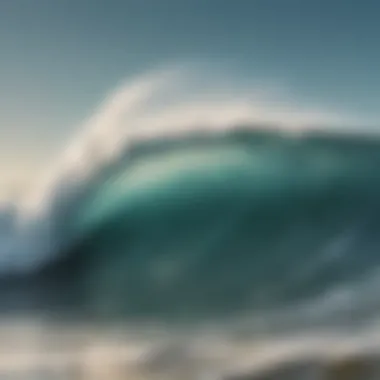
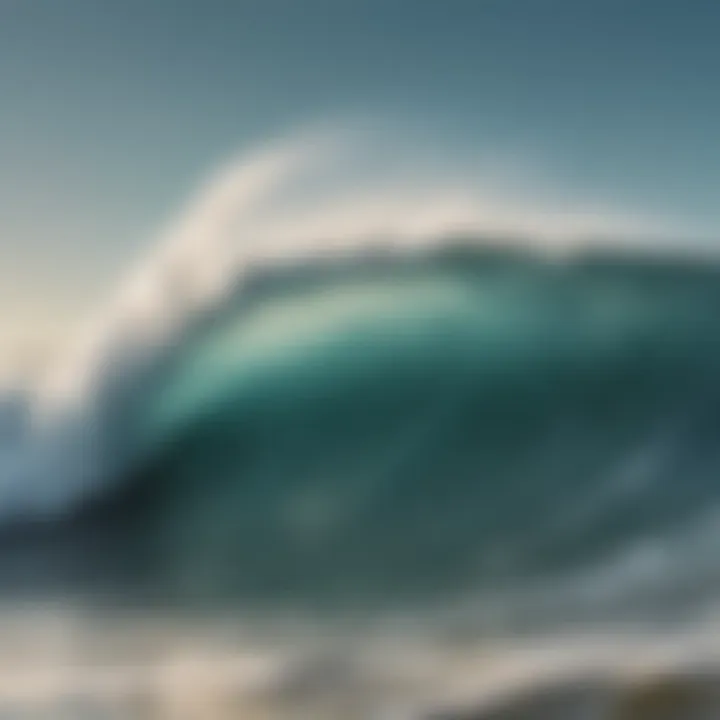
Intro
Understanding wind patterns is key for anyone who spends their time on the waves. While many surfers focus on the swells or tide, the wind plays a pivotal role in shaping the surfing conditions. It influences not just the size and direction of the waves but also affects how they break when they reach the shore.
For the uninitiated, winds can consist of many nuances. They swirl from different directions, gain momentum or slow down, switch from offshore to onshore, and sometimes just dance around without a care in the world. All these movements dictate the shape, size, and quality of waves. So, knowing about wind and its subtleties can mean the difference between a stellar surfing day and a lackluster one.
This article aims to walk you through how to read wind patterns effectively, examine their geographical influences, and offer insights specifically for surfboarders. With these tools at your disposal, you’ll be better equipped to choose the right conditions for a thrilling surf session.
Surfboarding Techniques
Surfers come from all walks of life. Some start young, while others might take it up later. Regardless of when you hit the surf, understanding a few techniques can help you ride those waves like a champ. Let's dig into some essentials for both beginners and seasoned surfers.
Beginner Tips for Mastering the Basics
Starting out in surfing can be as daunting as trying to navigate a ship through stormy seas. But it doesn't have to be. Here’s what every newbie should focus on:
- Choose the Right Surfboard: A stable board helps in maintaining your balance, making those initial rides smoother. Opt for a soft-top board if you’re just starting.
- Learn to Paddle Properly: Paddling is vital for getting out to the waves. Use your arms in a relaxed manner, keeping your body flat on the board. No need to tense up!
- Positioning is Key: Make sure to lie down on your board with your chest and hips centered. This balance will help you push up into a standing position smoothly.
- Timing Your Pop-Up: When you feel a push from a wave, it’s all about timing your pop-up. Bring your feet close to your chest and then aim to stand up swiftly.
Getting these basics down won't make you a master overnight, but they'll certainly set the stage for a more enjoyable surfing experience.
Advanced Techniques for Seasoned Surfers
For those who have caught a few good waves and feel ready to level up, here are some suggestions:
- Mastering Turns: Being able to perform smooth turns allows you to navigate different waves with greater control. Focus on pivoting your weight and use your back foot to guide the board.
- Reading Waves: Advanced surfers can predict wave formations. Knowing where the wave will break gives you a huge advantage. Observe the water closely before hitting the surf.
- Riding On Your Rails: This will enhance your speed and maneuverability. Practice shifting your weight from your toes to your heels as you ride.
Harnessing these techniques will not only increase your confidence but also enhance your overall experience in the water.
"The wind is a whisper, guiding each wave that surges forth, teaching surfers to dance in rhythm with nature's flow."
Surfboard Equipment
The right gear can make or break your surfing experience. It’s not just about the board, but a range of equipment that can take your performance up a notch. Here’s what to focus on.
Reviews of the Latest Surfboards on the Market
Picking a surfboard can feel like finding a needle in a haystack, given all the choices out there. Here’s a snapshot of some boards that have been making waves lately:
- Channel Islands Spine-Tek: Known for its durability and versatility, this board caters well to different skill levels, boasting a unique design that amplifies performance.
- Lost Surfboards Puddle Jumper: A favorite among those looking for a blend of speed and maneuverability, it thrives in small to medium surf. It's fun and easy to ride.
- Firewire Surfboards Timbertek: This one stands out not only for performance but also eco-friendliness. Firm and lightweight, it’s a solid pick for those concerned with carbon footprints.
Essential Gear for Every Surfboarder
Beyond the board, there are other important pieces of equipment every surfer should consider:
- Wetsuits or Rash Guards: Depending on the water temperature, a good wetsuit provides warmth and protection from the sun.
- Leashes: A crucial element, your leash keeps you connected to your board. Don’t skimp here!
- Wax: It keeps your feet from slipping off the board. The right mix of warmth and traction for the conditions can make all the difference.
Equipping yourself properly gives you the best chance on the waves, allowing you to focus less on the gear and more on the ride itself.
The Fundamentals of Wind
Understanding wind is essential in grasping its role within the broader context of surfing. Wind is not just a bystander in this incredible sport; it significantly influences wave formation, direction, and ultimately, the overall surfing experience. When surfers dial into wind fundamentals, they can better navigate how to select optimal surf spots, read forecasts, and adapt to changing conditions. This foundation aids in avoiding unpleasant surprises when hitting the waves. It’s not merely about knowing when to paddle out; it’s about having a keen awareness of the environment that surrounds the surf session.
Definition of Wind in Meteorological Terms
Wind, in meteorological terms, is the movement of air across the Earth’s surface. It originates from the uneven heating of the Earth's surface due to solar radiation. As different areas absorb varying amounts of heat, they create pressure variances, leading to air movement. Classic science may define it as force acting on a specific area, but for surfers, understanding that wind can build or flatten waves is the crux here. Wind can be categorized based on its speed and direction, which influences its impact on surfing conditions.
How Wind is Measured
Measuring wind accurately is crucial for surfers to make informed decisions. Several tools and scales provide the necessary data. Let's dive into some common methods:
Anemometers
Anemometers are specialized devices used for measuring wind speed. They come in various designs, from the familiar rotating cups to more advanced digital models. The vital aspect of anemometers is their ability to take precise readings, which helps surfers assess whether conditions are favorable for heading out. The cup-style is particularly popular among surf enthusiasts for its simplicity and reliability. However, one downside is that its readings may not always account for wind gusts effectively.
Beaufort Scale
The Beaufort Scale is an essential tool that categorizes wind speeds based on observed conditions at sea or on land. Its significance lies in its ability to translate wind speed into discernible effects on the water, like wave height or stability. The scale ranges from calm (0) to hurricane-force winds (12), making it incredibly useful for surfers to gauge conditions without direct measurements. A unique feature of the Beaufort Scale is its straightforwardness; however, it can sometimes lack specificity regarding actual speed, leading to misinterpretations.
Wind Direction Indicators
Wind direction indicators, such as wind vanes or flags, provide insights into where the wind is blowing from. Understanding the wind's direction is critical, as it directly impacts how waves break and whether they're suited for surfing. A benefit of these indicators is their simplicity; they can easily be used while out on the beach. However, their reliance on visual cues might not capture sudden changes in wind patterns, which can affect surfing decisions.
"Wind plays a vital role in the quality of waves, making it imperative for surfers to understand its dynamics to enhance their surfing experience."
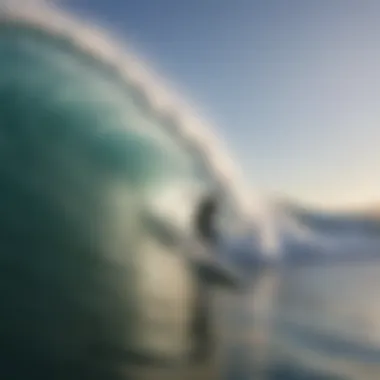
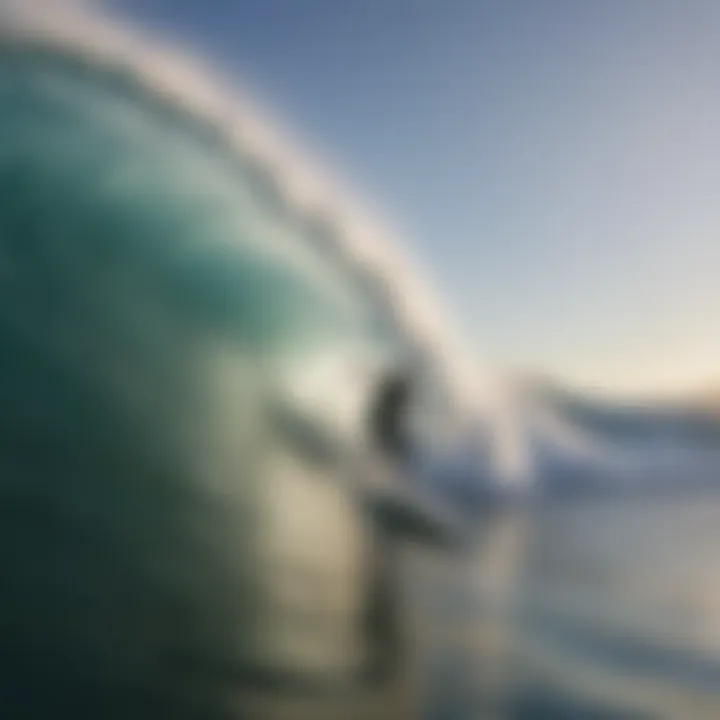
Global Wind Patterns
Global wind patterns play a crucial role in shaping our weather systems and, closely tied to this, sea conditions that surfers will experience. Recognizing the nuances in these wind currents can mean the difference between catching the perfect wave and struggling against unfavorable conditions. Understanding trade winds, westerlies, and polar winds helps surfers predict how different regions will behave, particularly when it comes to wave formation and surf spot selection. By factoring in these wind dynamics, surfers can enhance not only their surfing experience but also their safety in the water.
Trade Winds
Starting near the equator, trade winds are consistent and blow primarily from the east. These winds are a surfer's best friend, especially in tropical regions, as they often lead to clean, organized waves. When these winds pick up, they can drastically affect how and where waves break.
The trade winds can be a guiding force for those who enjoy long-distance paddling, as they push waves from the depths of the ocean towards the coast. Higher surf spots in areas like Hawaii or the Caribbean often benefit from these wind patterns, allowing for perfectly shaped waves to ride in upon shores.
Important Point: Trade winds help create the swell that forms the backbone of great surf spots. Without them, many surfers would find themselves looking at flat conditions.
Westerlies
As we move further from the equator and into temperate zones, westerlies take over. Contrary to the east-blowing trade winds, these winds blow from west to east. For surfers, the westerlies can mean mixed blessings. While they can help generate larger swells when they collide with local wind patterns, they could also stir up choppy waters that make paddling tiring and waves unpredictable.
In regions like California, individuals keen to surf need to heed the westerly winds seasonally. A strong westerly might lead to a day of rough surf; on the other hand, lighter winds can make for idyllic conditions. Knowledge of these winds can lead to wise timing and savvy surf spot selection—critical skills for any surfer trying to maximize their experience.
Polar Winds
Farther north and south lie the polar winds, which blow from the poles towards the equator. Although these winds are not typically associated with good surfing conditions, they can impact coastal temperature and weather patterns. In colder regions, particularly those getting winter storms, the polar winds can influence wave formation and how quickly conditions change.
In places like Northern Europe or Canada, understanding these winds can help surfers prepare for rapid changes in conditions. Packing warmth becomes essential as these winds might bring not only frigid temperatures but also sharp swells that require different techniques and strategies.
By understanding these three key global wind patterns—trade winds, westerlies, and polar winds—surfers gain a comprehensive view of how wind dynamics affect surf conditions. The next step is mastering the local effects of wind and how to read forecasts effectively.
Local Wind Effects
Local winds play a vital role in shaping surfing conditions, making their understanding crucial for surfers seeking the ideal wave. Unlike the more predictable global wind patterns, local winds are influenced by geographical features and can vary significantly within short distances. Their effects on wave formation and surfability can mean the difference between an optimal surf session and a disappointing outing.
Land and Sea Breezes
Land and sea breezes are classic examples of local wind phenomena that surfers should pay attention to. These breezes arise through differing heating rates between land and water.
During the day, the sun heats the land more quickly than the ocean, causing the air above the land to rise. This creates an area of lower pressure, and the cooler air over the water—remaining denser—flows in to fill that gap. This results in a refreshing sea breeze; for surfers, it often means smoother conditions and more favorable waves as the onshore winds tend to create a softer surf. However, these winds can change throughout the day.
In the evening, the process reverses as the land cools down faster than the sea, leading to a land breeze. This can create choppy conditions due to turbulent winds flowing off the land and into the ocean, which might disrupt the wave patterns. Thus, understanding these cycles can help surfers anticipate the conditions they'll encounter during their sessions.
Key Points on Land and Sea Breezes:
- Daytime Sea Breezes: Generally enhance wave conditions and can help form more defined peaks.
- Nighttime Land Breezes: Can lead to rougher, less predictable water surfaces.
- Timing your surf session to catch the sea breeze can optimize conditions.
Mountain and Valley Winds
Mountain and valley winds also provide a fascinating layer to local wind effects. In regions where terrain varies dramatically, these winds can influence surfing conditions more than one might expect. During the day, the sun heats the air in a valley more intensely than the air above the peaks, leading to ascending warm air. Cooler air from the mountains then moves down into the valley, creating a local wind that surfers should note.
When this air descends, it can generate gusts that disrupt wave formation at nearby surf spots. Conversely, at night, the cooling air can flow down the valleys into the ocean, again altering local surf conditions. Such winds can enhance or disrupt the surf, especially in coastal regions near mountainous areas where these shifts may happen frequently.
Considerations for Mountain and Valley Winds:
- Influence on Surf Quality: Down-valley winds can stir up surface chop, affecting smooth rides.
- Positioning: Surf spots that are more sheltered may benefit from more stable wind conditions.
- Location Awareness: Knowing how local mountains shape these winds can lead to smarter surf decisions.
Understanding local wind effects is not just a nice-to-have skill, it's essential for surfers looking to ride the best waves. Knowing when to be in the water can maximize enjoyment and performance.
In summary, local wind patterns, including land and sea breezes, as well as mountain and valley winds, present dynamic conditions that can radically change the surfing landscape. Recognizing how these winds operate and their potential impacts on surf quality is fundamental to any surfer looking to enhance their experience.
Understanding Wind Direction
Wind direction plays a pivotal role in shaping not just the atmosphere around us but also the very waves surfers ride. Understanding it is essential for anyone who spends time on the water. Wind does not simply blow in a straight line; it is influenced by numerous factors including geography, well-established patterns, and local anomalies. This knowledge empowers surfers to navigate their environment effectively, choose the right spots, and harness the conditions for the best possible experience.
Cardinal Directions
Cardinal directions—north, south, east, and west—are the foundational reference points for understanding wind patterns. When surfers talk about wind direction, it's crucial to appreciate how these points guide not only the identification of wind but also wave formation. For instance:
- North Winds can create less favorable surfing conditions, especially in regions that face north. These winds might bring in cold air and decrease wave size.
- South Winds can be a surfer’s best friend, often enhancing wave quality in many surf spots along the coast, particularly if you’re trying to catch a wave down south.
- East and West Winds can lead to more complex situations; east winds might clean up choppy waters while west winds can bring in pushier swells depending on your location.
In coastal areas, knowledge of these directions helps surfers anticipate wave behavior throughout the day. For example, on a day with a strong east wind, surfers might flock to the western beaches where the waves are more likely to hold up well. Understanding how these cardinal directions correlate to the local geography enhances a surfer's ability to choose when and where to ride.
Influence of Topography on Wind Direction
The landscape surrounding surf spots significantly alters natural wind patterns. Mountains, valleys, and coastal features all interact with the wind, bending it to create unique local conditions. Here's how topography impacts the wind direction:
- Obstructions and Channeling: Mountains acting as barriers can redirect winds. For instance, when wind encounters a mountain range, it often rises. This can lead to the creation of wind shadows on the leeward side, resulting in calmer conditions which can be favorable for surfing.
- Valley Winds: During the day, heats cause air over mountains to rise leading to a flow from the valley up towards them. At night, this pattern often reverses and cold air flows back down affected areas, altering wind patterns dramatically.
- Coastal Configurations: Reefs and points can help focus and direct wind flow, possibly affecting the size and consistency of waves. For example, a point break might have an offshore wind that creates clean, longer waves ideal for surfing.
In summary, understanding how topography influences wind direction is not merely academic—it's a practical toolkit for any surfer. Knowing where hills and valleys lie can enhance your ability to predict the waves and optimize your surf day.
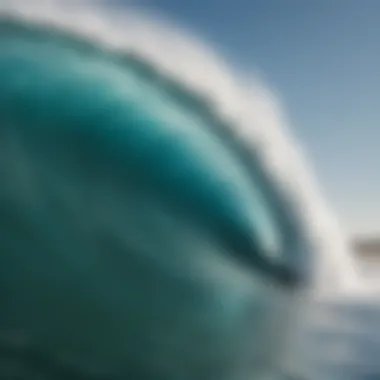
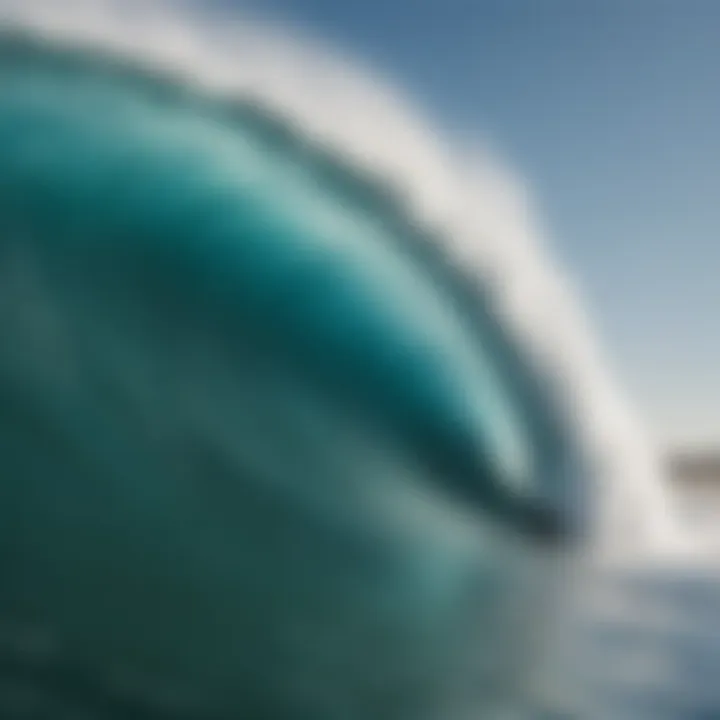
"The right wind can turn an ordinary surf day into an extraordinary one; it’s all about knowing how to read the signs."
By mastering these insights on wind direction, surfers equip themselves to make informed decisions that elevate their riding experience, aligning with both adventure and safety.
The Interplay Between Wind and Waves
The relationship between wind and waves is vital for surfers, as it sets the stage for the surfing experience. Understanding how wind affects wave formation and characteristics can make the difference between an unforgettable session and a ride with less-than-ideal conditions. When wind interacts with water, it creates waves that surfers become eager to ride. This interplay is influenced by various factors, including wind speed, direction, and even geographical considerations. Recognizing these elements equips surfers with knowledge to choose the best locations and times for surfing.
How Wind Influences Wave Formation
Wind plays a crucial role in wave creation. When wind blows across the surface of the ocean or any body of water, friction between the air and water leads to energy transfer. This energy causes ripples, which can develop into larger waves. Factors such as wind strength and duration directly impact wave formation. For instance, strong winds blowing consistently for a longer time will generally produce bigger and more powerful waves.
Additionally, the direction of the wind matters. Onshore winds tend to create choppy waters and poorly formed waves, while offshore winds can help to create clean, well-shaped waves ideal for surfing. The perfect wave is, therefore, a product of not just the wind speed and duration but also its direction and how it interacts with the ocean's surface.
"Wind is the brush that paints the waves; its influence shapes the art of surfing."
Wind Speed and Wave Height Relationship
The relationship between wind speed and wave height isn't just a mere correlation; it’s a dynamic interplay. As wind speed increases, wave height generally increases as well, up to a point. Each body of water has its own limits, known as the fetch—the uninterrupted expanse of water over which the wind blows. If the fetch is limited, even strong winds may not generate high waves.
For surfers, understanding this relationship helps in anticipating conditions at various surf spots. Generally, when wind speeds reach between 15 to 25 knots, surfers can expect decent waves.
In contrast, extreme wind speeds can lead to stormy conditions, giving rise to dangerous situations. Surfers should always assess wind speed, ensuring it aligns with safe and enjoyable wave conditions.
In summary, the intricate dance between wind and waves is foundational to the surfing experience. By keeping tabs on how these elements interact, surfers can better navigate their journeys.
*Understanding wind influence allows surfers to make smarter decisions—whether to hit the waves or wait for another day.
Choosing the Right Wind Conditions for Surfing
When it comes to riding the waves, selecting the right wind conditions can make or break a surfer's day at the beach. The wind does more than push the waves; it shapes their very character, and understanding how to choose the best conditions is crucial for surfers looking to catch optimal rides. In this section, we’ll break down some essential elements to consider when assessing wind conditions and how these factors play into the overall surf experience.
Offshore versus Onshore Winds
The difference between offshore and onshore winds isn't just a technicality; it's a matter of quality for surfers.
- Offshore Winds: These winds blow from the land towards the ocean. When the wind blows in this direction, it helps to hold up waves, creating clean faces and hollow sections, making for ideal surfing conditions. Many surfers seek out these winds, especially for those picture-perfect mornings. However, offshore winds can sometimes make conditions too tricky, especially for less experienced surfers.
- Onshore Winds: Onshore winds come from the ocean, moving towards land. While they can stir up some fun, they often lead to choppy water and mushy waves, which might not be the best for skilled tricks. For those learning the ropes, this might offer an easier ride, but for seasoned surfers, it often doesn't deliver that exhilarating feeling they crave.
"Understanding offshores and onshores is like knowing the signs of a good surf day versus a lukewarm one. It’s vital."
When planning a surfing adventure, checking the wind direction can be just as crucial as looking at the swell size or tide charts. Surf forecasts often provide wind information, so don't overlook these details.
Ideal Wind Speeds for Surfing
Wind speed plays a critical role in determining wave conditions. Too little wind can leave waves limp, while excessive speeds can create a chaotic sea that’s hard to navigate.
- Light Winds (1-10 knots): Generally, light winds are favorable for most surfers. They help preserve the wave shape, providing a smooth surf experience. Beginners might find these conditions particularly inviting, allowing them to practice and build confidence.
- Moderate Winds (11-20 knots): This range can be a double-edged sword. For some surfers, it’s the sweet spot, delivering just enough texture to the water without overly complicating wave forms. However, it may not work for all; certain locations and skill levels might make these winds less desirable.
- Strong Winds (21 knots and above): Strong winds add a layer of unpredictability to surfing. These conditions can lead to choppy waves, making it tougher to maintain balance and successfully execute moves. While some adventurous surfers might thrive in these situations, the risk of wipeouts increases significantly.
Impact of Wind on Surf Spot Selection
Wind is more than just a breeze on a sunny day; it plays a pivotal role in the world of surfing. Understanding how wind affects surf spots can mean the difference between catching that perfect wave or battling choppy, unrideable waters.
When it comes to surf spot selection, a few specific elements stand out. First, wind direction can either enhance or diminish wave quality. For instance, offshore winds can groom waves, giving them a clean face and a longer swell, creating more ideal conditions. In contrast, onshore winds often cause waves to become choppy and messy, ruining the surfing experience. The right wind can help you uncover hidden gems that thrive under specific conditions, while the wrong wind can turn a popular surf spot into a knotty, jumbled mess.
Identifying Optimal Surf Spots
Finding the best surf spots requires a keen eye on wind patterns and local topography. For many surfers, it’s essential to focus on two main aspects: wind direction and how it interacts with the coastline.
- Driving Winds: Think about how overhanging cliffs or other natural features can affect wind patterns. In some areas, sturdy cliffs can block adverse winds, making conditions far more favorable. Conversely, open beach breaks may react differently.
- Local Knowledge: Local surfers often share vital information about optimal conditions. Engaging with fellow wave riders or checking forums can reveal how certain spots react under specific wind influences and seasons. Sites like reddit.com will have discussions where surfers spill the beans about their secret spots!
A solid understanding of these dynamics lets surfers harness the winds to their advantage. If you know a spot is best with offshore winds, you can schedule your sessions accordingly.
Seasonal Variations in Wind Conditions
Seasons change, and so do wind patterns. Surf conditions fluctuate throughout the year, making it crucial for surfers to stay informed. Different regions experience unique seasonal shifts, affecting wind strength and direction.
In some coastal areas, summer winds may offer consistent offshore breezes, while winter months bring in onshore gales that can stir up more powerful waves but also create less desirable conditions for surfing.
Key Points to Consider:
- Wind Patterns: Keep an eye on seasonal forecasts. Knowing how patterns shift seasonally helps surfers prepare mentally and physically.
- Timing: Early mornings might offer glassy conditions in summer, but those winds can change by mid-morning, leading to chaotic waves.
- Climatic Changes: Don’t overlook long-term changes. Climate change can shift traditional wind patterns over time, affecting not just local surfing conditions but local ecosystems.
Those who take the time to study these seasonal variations can position themselves for success.
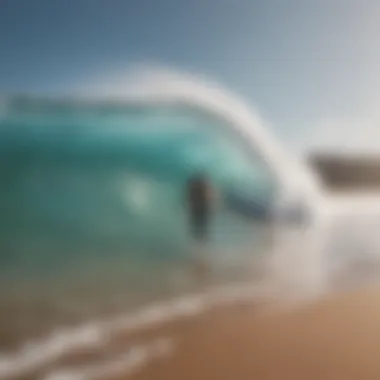

"The ocean is like life; the wind is just an element of its vast rhythm, influencing every wave that crashes upon the shore."
Environmental Considerations
When we discuss wind patterns in relation to surfing, we can’t ignore the broader environmental implications. Wind doesn’t just influence where waves break; it also plays an integral role in shaping ocean currents. Understanding the relationship between these elements is vital for surfers who are deeply connected to the ocean. It's not just about catching that perfect wave but also about appreciating the intricate systems at play beneath the surface.
Wind and Ocean Currents
Wind is the primary driver of ocean currents, which are massive flows of water that move through the oceans. These currents are critical for regulating climate and marine ecosystems. For example, the trade winds effectively push water toward the west in tropical regions, creating the Equatorial Current. This current is essential for redistributing warmth and nutrients across the ocean. As a result, it can lead to the creation of favorable surfing conditions in various locales.
Surfers should be cognizant of how prevailing winds impact these currents:
- Upwelling: In certain areas, wind can cause upwelling, where colder, nutrient-rich waters rise to the surface. This often leads to better surf conditions and a robust marine ecosystem.
- Eddy Formation: Wind-driven currents can create eddies, which are circular movements of water. These eddies can influence local wave patterns, creating unique surfing spots that change with the wind.
Understanding these dynamics can help surfers optimize their experience. For instance, some surfers will follow the shifting of these currents to find the best waves.
Effects of Climate Change on Wind Patterns
The discussion around wind patterns is not merely theoretical—it's becoming increasingly pressing due to climate change. From rising ocean temperatures to shifting atmospheric patterns, climate change is making its presence felt in the world of surfing.
Changes in wind patterns can have several effects:
- Increased Storm Frequency: The shifting climate leads to more unpredictable weather, which can escalate storm formation. This can periodically create challenging surfing conditions but also give rise to massive swells.
- Altering Wind Speeds and Directions: As the planet warms, wind speeds and directions may change. This has the potential to reshape surf conditions dramatically, as some areas may receive more consistent offshore winds, while others may not.
- Long-term Changes in Wave Patterns: Over months or years, climatological shifts can lead to new patterns in wave formation. These changes could render once-beloved surf spots less reliable or completely alter their characteristics.
"Surfers must adapt to the foreboding reality of climate change. Awareness and flexibility become essential skills for those who want to ride the waves sustainably."
Given these potential changes, it's essential for surfers and those involved in coastal community activities to remain informed. Keeping an eye on atmospheric conditions and being conscious of our environmental impact are crucial steps towards ensuring the longevity of surfing as a cherished activity.
By weaving together these threads of wind, ocean currents, and climate dynamics, surfers gain a richer understanding of their beloved pastime and the environment that sustains it.
Practical Tips for Surfers
When it comes to surfing, the wind plays an instrumental role that goes far beyond just a pleasant breeze. Understanding wind patterns is crucial for any surfer who aims to maximize their time on the water. This section focuses on practical tips that can help surfers navigate the sometimes capricious nature of wind conditions to enhance their overall surfing experience. By staying informed about wind dynamics, one can make better decisions regarding when and where to surf, ultimately leading to more enjoyable outings.
Tools to Track Wind Conditions
In the quest for perfect waves, having the right tools at hand can make all the difference. Here are some examples of essential tools surfers should consider using:
- Wind Forecast Apps: Applications like Windy or Surfline provide real-time wind data, including speed, direction, and gust patterns. These can be lifesavers for surfers who want to hit the water under optimal conditions.
- Anemometers: For those who prefer hands-on approaches, portable anemometers can measure wind speed precisely. A small investment can lead to a better understanding of local conditions in your favorite surf spots.
- Local Beach Reports: Surf schools or local surf shops often have bulletin boards or staff who can provide insights about the prevailing wind conditions. Tapping into the experience of seasoned surfers can yield valuable tips.
Using these tools enables surfers to keep tabs on changing conditions. A day that starts off perfect may morph into challenging conditions due to unexpected shifts in wind.
Adapting Surfing Techniques to Wind Conditions
Wind affects not only the waves but also the performance of a surfer on a board. The key to a successful surf session lies in adaptability—here are some ways to adjust your techniques accordingly:
- Positioning and Paddling: When facing onshore winds, surfers might find it more challenging to paddle out. It's wise to utilize the waves to push closer to the lineup. Conversely, with offshore winds, one can maintain momentum more easily, allowing for smoother paddling.
- Wave Selection: Different wind conditions create various types of surf breaks. A solid understanding of these nuances helps surfers select the right waves to catch. For instance, cross-shore winds may create choppy and unpredictable waves while offshore winds often lead to clean and groomed conditions.
- Adjusting Turns: When wind is strong, it can alter the dynamics of a bottom turn or aerial maneuver. Surfers should practice adjusting their body positioning and balance to counteract wind resistance. This can improve control and enhance performance even in less than ideal environments.
Keeping these practical tips in mind can lead to improved surfing experiences, ensuring that every wave ridden is inviting rather than daunting. Surfers should remember that understanding wind conditions is not just about reading forecasts—it's about intuitive adaptation and real-time responsiveness to the ocean’s whims.
Ending
Understanding wind patterns is not just a meteorological fancy—it directly shapes the surf experience. When surfers comprehend how wind influences wave formation and surf conditions, they can make wiser decisions about where and when to ride. This article emphasizes that wind patterns are the backbone of surfing conditions; they govern the nature of the waves, their size, and even their behavior.
A few key points stand out in grasping this concept:
- Wind Direction: The way wind blows significantly affects how waves form. Certain winds can create steep, powerful waves, while others might lead to choppy water.
- Optimal Conditions: By learning which wind conditions are ideal for specific spots, surfers can maximize their chances of catching the best waves. Winds typically blow in certain patterns based on geography, making some locations more favorable under particular conditions.
- Awareness of Changes: Surfers who are in tune with wind regularities and changes can adjust their plans swiftly, ensuring they don’t miss an opportunity. This adaptability can lead to better, safer surfing.
The need to be conscious of wind patterns extends beyond individual surfers. Surf instructors and adventurers also benefit from understanding these dynamics, as they guide others in exploring new surf territories. Ignoring wind influences can lead to missed opportunities or, worse, dangerous situations.
“Knowing the wind is like holding the keys to the ocean. With each gust, a new surf adventure awaits.”
In summary, wind awareness equips surfers with crucial knowledge, transforming their experience from guesswork to informed adventure. As surfers develop a more robust understanding of wind dynamics, they enhance not only their performance but also contribute to a culture of safety and respect for the ocean.
The Importance of Wind Awareness
Wind awareness matters greatly for surfers. Understanding how wind interacts with the ocean is crucial for capturing those perfect waves. When surfers think about wind direction and speed, they can anticipate the quality of the waves they’ll encounter.
For example, offshore winds are ideal. They help create cleaner, more structured waves. Knowing that a northeast wind can smoothen the surf in South California can be the difference between an okay session and a legendary one. On the flip side, onshore winds can lead to disorganized and choppy waters, which may discourage many surfers.
Additionally, a solid understanding of wind patterns helps surfers plan their trips more effectively, avoiding those windy days that take the fun out of riding. Here are some aspects which highlight the importance:
- Improving Performance: Surfers with a grip on wind dynamics can improve their ability to read the ocean, maneuver better, and pick the right moments.
- Safety Precaution: Knowledge of wind conditions can also serve as a safeguard against hazardous surf. Unfavorable winds can create dangerously crowded or unstable waters.
- Community Building: By sharing insights about local wind conditions where surfers congregate, a knowledgeable surfing community emerges that thrives on safe practices.
Future Trends in Wind Studies and Surfing
Looking forward, the landscape of wind studies in relation to surfing is poised for transformation. With advancements in mapping technology and real-time data collection, surfers will have access to increasingly accurate wind forecasts. This will allow them to fine-tune their choices regarding when and where to surf more than ever before.
Some of the trends that may influence both the surfing world and wind research can include:
- AI and Predictive Modeling: Utilizing artificial intelligence to predict variations and fluctuations in wind could shift how we approach surfing sessions. The integration of machine learning could lead to predictions that help surfers choose peak conditions.
- Environmental Awareness: As the world grapples with climate change, the study of wind patterns will become increasingly relevant. Understandings of how shifts in wind patterns impact marine ecosystems and surf conditions will gain importance.
- Emerging Research: Universities and environmental organizations are likely to increase funding for research centered on wind dynamics and surfing, leading to enhanced knowledge about localized wind variations and their influences on wave quality.















